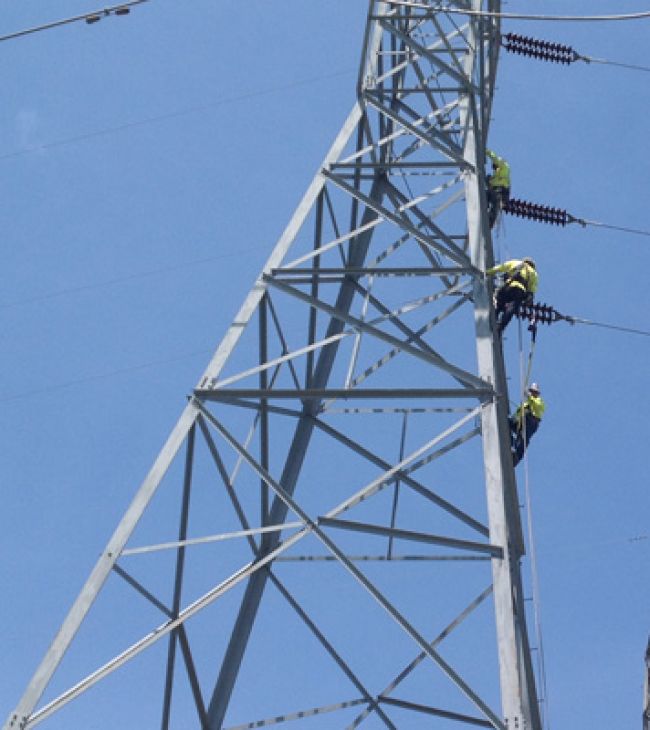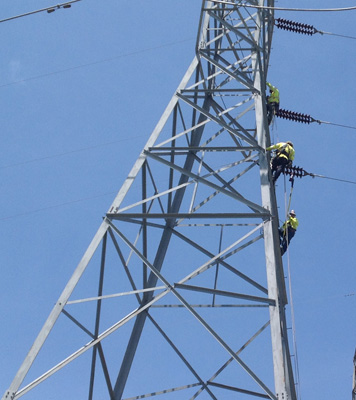
Safety Best Practices for Outage Season

Football season is here, and hunting season is right around the corner. That means it’s also outage season for the electric power industry.
Planned outages allow utilities to take equipment out of service for maintenance, replacement or new construction. The timing is dictated by the utility owners and the regional transmission organizations that oversee the power grid. Planned outages can last from 15 minutes to months, and they can be continuous or intermittent. Most occur late in the year because loads are lower than during the peak summer and winter months. In addition, utilities need to use up their capital budgets for the year.
The height of outage season is between Thanksgiving in the U.S. and Christmas. With the rush to perform outages as quickly as possible, they often entail 12- to 16-hour workdays and seven-day workweeks for crews. Given the pace and intensity, along with the weather conditions, the potential for injuries is significant. To combat these risks, following are a number of best practices that can be used in your organization to help keep crews safe during outage season.
Site-Specific Safety Plan
Safely performing an outage begins with the crew developing a comprehensive, site-specific safety plan that – at a minimum – addresses manpower, equipment, logistics, training and emergency response. Because planning for most outages takes months, there’s plenty of time to thoroughly address safety.
Manpower
When developing the safety plan, establish how many workers will be needed to perform tasks safely and efficiently. In particular, consider work hours, because expecting workers to put in too many hours increases the risk of something going wrong on the job. Do you need 10 employees to perform 16-hour shifts seven days a week, or is it more prudent to ask 20 employees to work 10-hour shifts for five days?
Equipment
Determine the construction equipment you’ll need, and keep in mind that you must be prepared for unexpected situations. If the right equipment is unavailable, you may face unacceptable delays, or workers may expose themselves to danger by using the wrong equipment.
Logistics
Make sure all materials for the project will be on hand and staged properly. Address specific work areas, drive paths and safe locations for staging away from energized equipment. If you’ll be working with outside contractors, involve them in your planning.
I recall two similar A-frame erection projects that demonstrated the value of staging. At the first site, proper staging allowed the contractor to complete the work in just seven hours. At the second site, the same work without staging took five days.
Training
Provide staff training before an outage begins. Trying to train less-skilled workers during the short window of an outage is stressful for both the trainer and trainees. Allow enough time to proceed step by step and answer questions.
Emergency Response
Outage work is often performed in isolated areas, so plan for possible emergencies. Meet with local first responders and familiarize them with the work you’ll perform and the associated hazards. Because a volunteer fire department may not have the skills or equipment to retrieve a suspended worker near energized devices, be sure your plan addresses what you’ll do should that situation occur.
Additionally, familiarize the crew with medical facility locations by driving them there. Identifying the nearest hospital or clinic isn’t enough. I recall a project during which the supervisor drove someone with chest pains to the designated medical facility, only to discover it had been torn down, and then had to race in the opposite direction to find a hospital.
Reviewing Clearance Points
As you receive clearance orders, request a copy of the switching orders. Review the open points and clearance zone with the team. Perform walk-throughs to verify that switches are open. If you’re on a transmission project between distant substations, take the time to drive to each substation and visually inspect the switches.
Tag clearance points to ensure visibility, and walk the paths with the entire crew and the utility owner. In larger substations, use caution tape or snow fence to delineate energized bays. Review the clearance points regularly, and when new people join the crew, walk them through the points.
Grounding
It is critical to verify grounding is in place and to inspect grounds at least daily because they can become loose from vibration and weather conditions. Apply high-visibility flags to grounds. Make sure the proper equipment and sizes are being used and that everything is attached. Do not leave grounds coiled after installation; they can flail if they become energized. Workers should always position themselves between grounds and use personal safety grounds because induced voltage can kill.
Task Hazard Analysis
Reminding the crew to update and seriously review the task hazard analysis (THA) is crucial to preplanning. Engaging in these actions forces workers to slow down in order to recognize and eliminate potential hazards that may otherwise go unnoticed.
A THA – which some organizations may refer to as a job hazard analysis or job safety analysis – details all of the steps involved in the performance of a task, the hazards associated with each of those steps and actions that will mitigate those hazards. While a THA is a fairly simple document, its true value arises from the process used in its development.
The most effective approach is to have the individuals who will perform the tasks create the THAs for those tasks. Why? Two reasons. First, the people who will perform the work typically know the process, the job site and the inherent hazards better than anyone else. They are intimately familiar with each step of a task and have firsthand experience with problems that may arise. They recognize the strongest supports and the slickest surfaces, and they are aware of trends that may be affecting the workplace.
Second, by creating the THA, workers take an active role in their own safety planning. They have to think carefully about each of the steps associated with the task, visualize what could go wrong and identify the most sensible solution. Then they have to commit that information to paper. The process touches on several different learning styles, making it more memorable and meaningful for the workers.
The best THAs are highly detailed, spelling out even those steps that may seem obvious. Some workers try to generalize and condense steps, so they end up listing jobs instead of the underlying tasks. It’s far more effective if the workers write down each step, move to the next column and list the hazards associated with that step, and then move to the next column to describe the mitigation strategy. Once that’s done, they can move to the next step and repeat the process.
THAs are living documents that should change with the project. They should be reviewed after lunch and any other lengthy breaks in an effort to ensure the information is still fresh in workers’ minds. In addition, a change in task or setting demands development of a new THA. For example, if the work area changes – perhaps a crew is guiding the placement of steel on one side of a substation and work moves to the other side of the substation – the hazards and work angles may be vastly different. Before work resumes, the crew needs to develop a THA that reflects the changes.
Multiemployer Worksites
Often during outages, there will be many contractors working on the same site. These contractors may be working for different business units, client contacts, or they could be second- or third-tier subcontractors. Whatever the case, the presence of multiple contractors on one site has the potential to lead to miscommunication in the field and unintentional hazardous situations.
It is crucial that all parties on-site discuss daily work plans and sign off on each other’s job briefings or THAs. This should be done routinely, especially any time the scope of work changes during the course of the day. Take the time to talk – this small effort could potentially save a life.
Worker Health
Be alert to worker health and fatigue, particularly with regard to extended hours that contribute to physical and mental stress. Fatigue reduces the ability to concentrate and increases the chance of operator error and accidents. Smart contractors rotate workers and give them time off for every 10 days they work.
Monitor nutrition and hydration. Workers living away from home don’t eat as well as they do at home. Encourage smaller, lighter, healthier meals and staying hydrated. Discourage alcohol use, which can cause dehydration and poor work performance the next day. Be on the lookout for behavioral changes that may signal extreme fatigue or other physical problems.
Finally, emphasize morning stretch and flex activities, which can reduce strain, soft tissue and lower back injuries. The highest-ranking official on the job site should lead these exercises to emphasize their importance and ensure that everyone takes them seriously. A few minutes of stretching can prevent days of lost work time, and that’s critically important given the short timetables of planned outage projects.
About the Author: Jordan Hollingsworth, CHST, CSP, CUSP, is a lead adviser for Safety Management Group, a professional service organization that provides safety advisers to support transmission and distribution projects. He also is a certified safety professional who has spent over nine years assisting contractor safety management programs.

